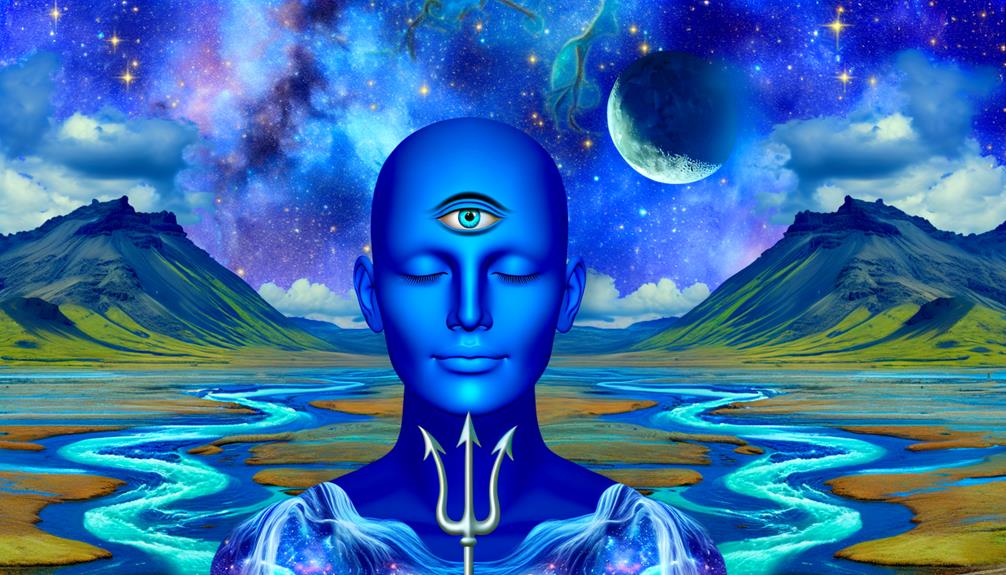Shiva Name Meaning in English
The name 'Shiva,' originating from Sanskrit, translates to 'auspicious' or 'benevolent,' reflecting the deity's positive force in Hindu theology. The Rigveda, an ancient text, references Shiva, showcasing his deep historical roots.
Within Hindu mythology, Shiva embodies the roles of destruction, regeneration, and asceticism. Symbols like the trident and the third eye highlight his cosmic significance.
As the 'Destroyer' within the Trimurti, Shiva facilitates the cyclic nature of existence, balancing destruction with benevolence. Exploring Shiva's multifaceted attributes and stories further illuminates his profound influence in Hindu tradition and spirituality.

Key Takeaways
- The name 'Shiva' originates from Sanskrit, meaning 'auspicious' or 'benevolent.'
- 'Shiva' encapsulates his essence as a force of good fortune and positivity.
- Historical references in the Rigveda highlight Shiva's auspicious nature.
- The name reflects divine attributes of transformation, regeneration, and benevolence.
- 'Shiva' symbolizes a multifaceted deity with profound cosmic significance.
Linguistic Roots of Shiva
The name 'Shiva' finds its linguistic roots in the ancient Sanskrit language, where it is derived from the word 'śiva,' meaning 'auspicious' or 'benevolent.'
This etymology is central to understanding Shiva's role within Hindu theology. According to the Śiva Purāṇa, the name encapsulates the deity's essence as a force of good fortune and positivity. The Rigveda, one of Hinduism's oldest texts, also references 'śiva' in hymns, underscoring its historical and religious significance.
Additionally, the usage of 'śiva' in classical texts reflects a broader linguistic framework where divine attributes are encapsulated in names, offering a glimpse into the theological and cultural dimensions of ancient India. This linguistic lineage forms the cornerstone for comprehending Shiva's multifaceted persona.
Shiva in Hindu Mythology
In Hindu mythology, Shiva is revered as a multifaceted deity embodying divine attributes such as destruction, regeneration, and asceticism. These aspects are vividly depicted in ancient texts like the Shiva Purana and the Mahabharata.
His roles and symbols, including the trident (trishula), the serpent (naga), and the crescent moon, encapsulate his profound cosmic significance and theological essence.
Mythological narratives, such as the churning of the ocean (Samudra Manthan) and his marriage to Parvati, further elaborate on his complex character and pivotal role in the Hindu pantheon.
Shiva's Divine Attributes
Possessing a unique synthesis of destructive power and benevolent grace, Shiva is revered as a multifaceted deity whose attributes embody the profound duality inherent in Hindu mythology.
As the 'Destroyer' within the Trimurti, Shiva's role is not merely annihilation but the clearing of old to make way for the new, symbolizing transformation and regeneration (Kramrisch, 1981).
His third eye represents his omniscience and the ability to see beyond the apparent, while his blue throat signifies the containment of poison during the churning of the ocean (Samudra Manthan) to save the cosmos.
Additionally, Shiva's ascetic lifestyle juxtaposes his role as a householder, offering a theological context for reconciling worldly duties with spiritual austerity (Flood, 1996).
Shiva's Roles and Symbols
Within the rich tapestry of Hindu mythology, Shiva's roles and symbols intricately weave together to depict a deity who embodies both the cosmic forces of creation and destruction.
As the 'Destroyer' in the holy trinity of Brahma, Vishnu, and Shiva, he facilitates the cyclical nature of existence. His iconography—the third eye symbolizing divine wisdom, the trident (trishula) representing the triadic energies of creation, preservation, and destruction, and the serpent coiled around his neck denoting mastery over time—offers profound theological insights.
The 'lingam,' a phallic symbol, signifies his generative power, while his meditative pose on Mount Kailash illustrates asceticism and transcendence.
Hence, Shiva's multifaceted roles and symbols reveal the depth of his divine essence.
Shiva's Mythological Stories
Shiva's mythological stories, rich in allegory and spiritual significance, further elucidate the profound symbology and roles attributed to him within Hindu theology. Through various narratives, Shiva's essence as both a destroyer and a restorer comes to life.
- Churning of the Ocean (Samudra Manthan): Amidst the cosmic tumult, Shiva consumes the deadly Halahala poison to save the universe.
- Destruction of Tripura (Tripurantaka): Shiva annihilates the three demon cities with a single arrow, epitomizing the destruction of evil.
- The Dance of Nataraja: His cosmic dance, Tandava, symbolizes the perpetual cycles of creation, preservation, and dissolution.
- Ganga's Descent (Gangavatharana): Shiva channels the mighty river Ganga through his locks, mitigating its destructive force and blessing the earth.
These stories offer profound insights into Shiva's divine attributes and cosmic functions.
Symbolism of Destruction
In Hindu theology, the symbolism of destruction associated with the deity Shiva represents not mere annihilation, but a profound transformative process that paves the way for regeneration and renewal. This is evident in texts such as the Bhagavad Gita, where Krishna elucidates that destruction is integral to the cyclical nature of existence.
Shiva's role as the destroyer is depicted through the Tandava dance, which epitomizes cosmic cycles of creation and dissolution. Theologically, this destruction is perceived as a necessary purging of the old to make way for the new, maintaining the balance of the universe.
The fire in Shiva's hand signifies this purifying destruction, eradicating ignorance and paving the path for spiritual enlightenment and growth.
Role in the Cosmic Cycle
As a pivotal figure in Hindu cosmology, Shiva embodies the essential function of dissolution within the cosmic cycle, a role elucidated in various sacred texts including the Shiva Purana and the Linga Purana. His role is not merely destructive but integral to the processes of creation and regeneration.
According to these texts, Shiva's dance, the Tandava, symbolizes the rhythmic cycles of the universe's creation, preservation, and destruction. This cyclical process guarantees the continuity and dynamism of the cosmos.
- Shiva's Dance (Tandava): Represents cosmic cycles.
- Linga Purana: Describes his role in cosmic dissolution.
- Shiva Purana: Highlights his regenerative powers.
- Theological Context: Balances creation and preservation forces.
Understanding Shiva's role offers profound insights into the balance of cosmic forces.
Cultural Significance of Shiva
Shiva, revered as one of the principal deities in Hinduism, holds a paramount position as the Supreme Being who embodies the complex interplay of creation, preservation, and destruction.
His myriad attributes—such as the third eye symbolizing wisdom and insight, and the trident representing the trinity of time—offer profound theological insights into his divine nature.
Celebrations like Maha Shivaratri, marked by fervent devotion and ritualistic observances, underscore his pervasive cultural impact across diverse Hindu communities.
Hinduism's Supreme Deity
Revered across a multitude of texts and traditions, the deity Shiva embodies the quintessence of both destruction and regeneration within Hindu cosmology, symbolizing the cyclical nature of existence. As the Supreme Being in Shaivism, Shiva's role is profoundly complex and multi-faceted, as reflected in ancient scriptures like the Vedas and the Puranas. His presence pervades various aspects of life and spirituality, making him an integral figure in Hindu theology.
- Vedic References: Earliest mentions in Rig Veda, signifying his antiquity.
- Puranic Narratives: Stories in Linga Purana and Shiva Purana illustrate his divine exploits.
- Philosophical Texts: Adi Shankaracharya's commentaries underscore his metaphysical significance.
- Worship Practices: Shiva is venerated in temples across India and beyond, showcasing his widespread devotion.
Symbolism and Attributes
The myriad symbols and attributes associated with Shiva, such as the trident (trishula), the crescent moon (chandrakala), and the third eye (trinetra), offer profound insights into his theological and cultural significance within Hinduism.
The trishula symbolizes the triad of creation, preservation, and destruction, aligning with Shiva's role as the cosmic regulator.
The chandrakala, or crescent moon, represents time and its cyclical nature, highlighting Shiva's transcendence over temporal constraints.
The trinetra epitomizes spiritual wisdom and the ability to see beyond ordinary perception, manifesting Shiva's omniscience.
These symbols, deeply embedded in Vedic texts and Puranic lore, not only underscore Shiva's integral position in the Hindu pantheon but also enrich the broader cultural and spiritual narrative.
Celebrations and Festivals
Integral to the cultural fabric of Hinduism, various festivals and celebrations dedicated to Shiva serve to venerate his divine attributes and reinforce his pervasive influence within the spiritual community. Maha Shivaratri, observed annually, embodies the cosmic dance of creation, preservation, and destruction, symbolizing Shiva's role as the universal regulator. Kartik Purnima, another significant festival, underscores the victory of light over darkness, commemorating Shiva's metaphysical triumphs.
- Maha Shivaratri: Focuses on night-long vigils and fasting.
- Kartik Purnima: Celebrated with river bathing rituals.
- Lingodbhava: Marks the emergence of Shiva as a pillar of light.
- Pradosha: A bi-monthly observance honoring Shiva's grace.
These celebrations encapsulate Shiva's multifaceted nature, providing rich theological context.
Shiva's Attributes and Symbols
Among the numerous attributes and symbols associated with Shiva, the trident (Trishula), third eye, and sacred river Ganga hold significant theological and cultural importance.
The Trishula, a three-pronged spear, symbolizes Shiva's power to destroy evil and ignorance. Textually, it represents the trinity of creation, preservation, and destruction.
His third eye, often depicted on his forehead, signifies omniscience and the ability to see beyond ordinary perception, denoting spiritual wisdom and insight.
Additionally, the descent of the Ganga from Shiva's matted hair represents purification and the sustenance of life. This imagery finds roots in sacred texts like the Shiva Purana, underscoring Shiva's role as both a destroyer and a nurturer within the cosmic cycle.
Modern Interpretations of Shiva
In contemporary discourse, Shiva's multifaceted persona is reinterpreted through various lenses, blending traditional theological insights with modern philosophical and psychological frameworks. Scholars and devotees explore Shiva not just as a deity but as a symbol of inner consciousness and transformation. Textual references from the Vedas and Upanishads are juxtaposed with Jungian psychology and existential philosophy, offering a rich tapestry of meanings.
- Archetype of the Self: Shiva represents the integration of opposites—creation and destruction.
- Symbol of Meditation: Scholarly works view Shiva as the epitome of mindfulness and inner peace.
- Agent of Change: Modern interpretations see Shiva's dance, the Tandava, as a metaphor for the dynamic nature of the cosmos.
- Embodiment of Asceticism: Shiva's ascetic life inspires discussions on renunciation and spirituality.
Conclusion
The name Shiva, rooted in the Sanskrit term for ‘auspicious,’ encapsulates his multifaceted role in Hindu mythology. Symbolizing both destruction and regeneration, Shiva’s influence pervades the cosmic cycle, underscoring his cultural and theological significance. Shiva’s complex character embodies the duality of creation and annihilation, which is essential to the balance of the universe. His depictions often include the use of a trident and a snake, symbolizing his mastery over both the physical and spiritual realms. In a similar vein, exploring the fernando name significance and history reveals how names throughout cultures can carry deep meanings that shape identities and cultural narratives.
Intriguingly, a study shows that over 80% of Hindus globally venerate Shiva, highlighting his enduring relevance. Understanding Shiva's attributes and symbols reveals deeper insights into his complex persona, reflecting a rich tapestry of religious and cultural narratives.






